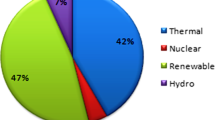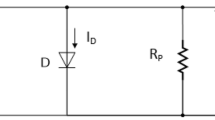Abstract
Maximum Power Point Tracking (MPPT) controller is required in a solar photovoltaic (PV) system to deliver the maximum power to load from PV module. This paper proposes a novel stepped MPPT method to realize a simple MPPT controller, which can track the real maximum power point (RMPP) even under partial shading conditions. The proposed algorithm is started by scanning the characteristic curve of the PV modules to detect the global maximum power point and then the algorithm will be switched to the conventional P&O algorithm to track the true maximum power point. The obtained simulation results, using Power electronic simulation software (PSIM), are compared with those found using the P&O method to confirm the performance of our proposed MPPT method even under non-uniform solar irradiation.
Similar content being viewed by others
References
Mukti, R.J. and Islam, A., Modelling and performance analysis of PV module with Maximum Power Point Tracking in Matlab/Simulink, Appl. Sol. Energy, 2015, vol. 51, pp. 245–252.
Mouna, B.H. and Lassaâd, S., A maximum power tracking algorithm based on photovoltaic current control for matching loads to a photovoltaic generator, Appl. Sol. Energy, 2012, vol. 48, pp. 238–244.
Sera, D., Mathe, L., Kerekes, T., et al., On the perturband-observe and incremental conductance MPPT methods for PV systems, IEEE J. Photovolt., 2013, vol. 3, pp. 1070–1078.
Patil, M. and Deshpande, A., Design and simulation of perturb and observe Maximum Power Point Tracking in MATLAB and Simulink, in Proceedings of the International Conference ICSTM, 2015, pp. 459–465.
Safari, A. and Mekhilef, S., Simulation and hardware implementation of incremental conductance MPPT with direct control method using buck converter, IEEE Trans. Ind. Electron., 2011, vol. 58, pp. 1154–1161.
Liu, B., Duan, S., Liu, F., and Xu, P., Analysis and improvement of Maximum Power Point Tracking algorithm based on incremental conductance method for photovoltaic array, in Proceedings of the Conference on Power Electronics and Drive Systems, 2007, pp. 637–641.
Yan, Z., Fei, L., Jinjun, Y., and Shanxu, D., Study on realizing MPPT by improved incremental conductance method with variable step-size, in Proceedings of the Conference IEEE Industrial Electronics and Applications, 2008, pp. 547–550.
Yu, G., Jung, Y., Choi, J., and Kim, G., A novel twomode MPPT control algorithm based on comparative study of existing algorithms, Solar Energy, 2004, vol. 76, pp. 455–463.
Ishaque, K. and Salam, Z., A review of Maximum Power Point Tracking techniques of PV system for uniform insolation and partial shading condition, Renewable Sustainable Energy Rev., 2013, vol. 19, pp. 475–488.
Patcharaprakiti, N. and Premrudeepreechacharn, S., Maximum Power Point Tracking using adaptive fuzzy logic control for grid-connected photovoltaic system, in Proceedings of the Power Engineering Society Winter Meeting IEEE, 2002, pp. 372–377.
Karatepe, E. and Hiyama, T., Artificial neural network-polar coordinated fuzzy controller based Maximum Power Point Tracking control under partially shaded conditions, IET Renewable Power Generat., 2009, vol. 3, pp. 239–253.
Bahgat, A., Helwa, N., Ahmad, G., and El Shenawy, E., Maximum Power Point Tracking controller for PV systems using neural networks, Renewable Energy, 2005, vol. 30, pp. 1257–1268.
Noguchi, T., Togashi, S., and Nakamoto, R., Shortcurrent pulse-based maximum-power-point tracking method for multiple photovoltaic-and-converter module system, IEEE Trans. Ind. Electron., 2002, vol. 49, pp. 217–223.
Sun, X., Wu, W., Li, X., and Zhao, Q., A research on photovoltaic energy controlling system with maximum power point tracking, in Proceedings of the Conference on Power Conversion PCC, Osaka, 2002, pp. 822–826.
Shi, J., Zhang, W., Zhang, Y., et al., MPPT for PV systems based on a dormant PSO algorithm, Electric Power Syst. Res., 2015, vol. 123, pp. 100–107.
Ji, Y.H., Jung, D.Y., Won, C.Y., et al., Maximum Power Point Tracking method for PV array under partially shaded condition, in Proceedings of the Conference IEEE Energy Conversion Congress and Exposition, 2009, pp. 307–312.
Femia, N., Granozio, D., Petrone, G., et al., Optimized one-cycle control in photovoltaic grid connected applications, IEEE Trans. Aerospace Electron. Syst., 2006, vol. 42, pp. 954–972.
Bayod-Rújula, A.A. and Cebollero-Abián, J.A., A novel MPPT method for PV systems with irradiance measurement, Solar Energy, 2014, vol. 109, pp. 95–104.
Kobayashi, K., Takano, I., and Sawada, Y., A study of a two-stage Maximum Power Point Tracking control of a photovoltaic system under partially shaded insolation conditions, Sol. Energy Mater. Sol. Cells, 2006, vol. 90, pp. 2975–2988.
Petrone, G., Spagnuolo, G., Teodorescu, R., et al., Reliability issues in photovoltaic power processing systems, IEEE Trans. Ind. Electron., 2008, vol. 55, pp. 2569–2580.
Hua, C. and Shen, C., Comparative study of peak power tracking techniques for solar storage system, in Proceedings of the Applied Power Electronics Conference APEC’98, 1998, pp. 679–685.
Hohm, D. and Ropp, M., Comparative study of Maximum Power Point Tracking algorithms using an experimental, programmable, Maximum Power Point Tracking test bed, in Proceedings of the 28th IEEE Conference, 2000, pp. 1699–1702.
Hussein, K., Muta, I., Hoshino, T., and Osakada, M., Maximum photovoltaic power tracking: an algorithm for rapidly changing atmospheric conditions, Proc. IEEE, Transmis. Distrib., 1995, vol. 142, pp. 59–64.
Esram, T. and Chapman, P.L., Comparison of photovoltaic array Maximum Power Point Tracking techniques, IEEE Trans. Energy Convers., 2007, vol. 22, p. 439.
Milde, M. and Oldenkamp, H., Maximum Power Point Tracking performance under partially shaded PV array conditions, in Proceedings of the 21st European Photovoltaic Solar Energy Conference and Exhibition, Dresden, 2006, pp. 2157–2160.
Kofinas, P., Dounis, A.I., Papadakis, G., and Assimakopoulos, M., An intelligent MPPT controller based on direct neural control for partially shaded PV system, Energy Buildings, 2015, vol. 90, pp. 51–64.
Lei, P., Li, Y., and Seem, J.E., Sequential ESC-based global MPPT control for photovoltaic array with variable shading, IEEE Trans. Sustainable Energy, 2011, vol. 2, pp. 348–358.
Nguyen, T.M., Dunnigan, M.W., and Mueller, M.A., Global MPPT of solar PV modules using a dynamic PSO algorithm under partial shading conditions, in Proceedings of the Conference on Clean Energy and Technology CEAT, IEEE, 2013, pp. 134–139.
Gokilapriya, D. and Banu, S.B., MPPT measurement of photovoltaic system under partial shading condition using DPSO algorithm, in Proceedings of the Conference on Power Electronics and Renewable Energy Systems, India: Springer, 2015, pp. 1037–1046.
Taheri, H., Salam, Z., and Ishaque, K., A novel Maximum Power Point Tracking control of photovoltaic system under partial and rapidly fluctuating shadow conditions using differential evolution, in Proceedings of the IEEE Symposium on Industrial Electronics and Applications ISIEA, 2010, pp. 82–87.
Farayola, A.M., Hassan, A.N., and Ali, A., Implementation of modified incremental conductance and fuzzy logic MPPT techniques using MCUK converter under various environmental conditions, Appl. Sol. Energy, 2017, vol. 53, pp. 173–184.
Ding K., Bian, X., and Liu, H., Matlab-Simulink based modelling to study the influence of nonuniform insolation photovoltaic array, in Proceedings of the International Conference on Power and Energy Engineering APPEEC, Asia-Pacific, 2011, pp. 1–4.
Mohanty, P., Bhuvaneswari, G., Balasubramanian, R., and Dhaliwal, N.K., MATLAB based modelling to study the performance of different MPPT techniques used for solar PV system under various operating conditions, Renewable Sustainable Energy Rev., 2014, vol. 38, pp. 581–593.
Ramdan, B., Comparison between the conventional methods and PSO based MPPT algorithm for photovoltaic systems, Int. J. Energy Power Eng., 2014, vol. 8, pp. 690–695.
Jubaer, A. and Zainal, S., A Maximum Power Point Tracking (MPPT) for PV system using Cuckoo search with partial shading capability, Appl. Energy, 2014, vol. 119, pp. 118–130.
Kai, C., Shulin, T., Yuhua, C., Senior, M., and Libing, B., An improved MPPT controller for photovoltaic system under partial shading condition, IEEE Trans. Sustainable Energy, 2014, vol. 5, pp. 978–985.
Eftichios, K.M. and Blaabjerg, F., A new technique for tracking the global Maximum Power Point of PV arrays operating under partial-shading conditions, IEEE J. Photovolt., 2012, vol. 2, pp. 184–190.
Author information
Authors and Affiliations
Corresponding author
Additional information
The article is published in the original.
About this article
Cite this article
Sellami, A., Kandoussi, K., El Otmani, R. et al. A Novel Auto-Scaling MPPT Algorithm based on Perturb and Observe Method for Photovoltaic Modules under Partial Shading Conditions. Appl. Sol. Energy 54, 149–158 (2018). https://doi.org/10.3103/S0003701X18030143
Received:
Published:
Issue Date:
DOI: https://doi.org/10.3103/S0003701X18030143




